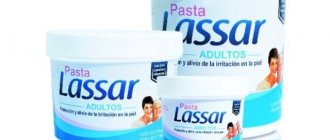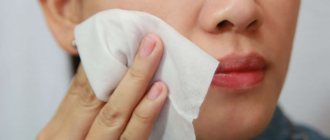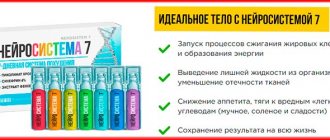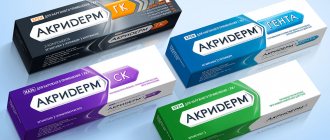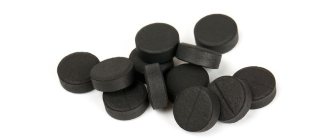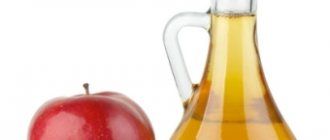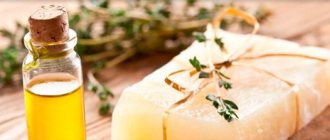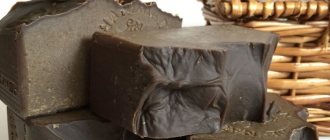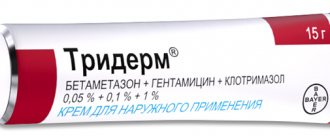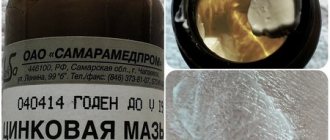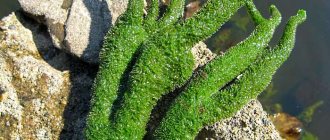In caring for skin, especially problem skin , not only cosmetics, but also pharmaceutical preparations help. Some of them may well solve the problem of acne.
Panthenol for acne has proven itself to be an effective remedy that takes care of the skin better than any expensive cream.
The effective effect of this drug can be felt if you know how to correctly use each of its forms to get rid of acne and inflammation.
Description of the drug
The direct purpose of the drug is to moisturize the skin, as well as help restore the epidermis in case of cuts, abrasions, burns or other damage.
- The product is made on the basis of pantothenic acid,
- Has anti-inflammatory, antibacterial effect,
- Has an analgesic effect,
- Accelerates the processes of regeneration of tissues and mucous membranes,
- Helps normalize cellular metabolism,
- Has a beneficial effect on the strength and condition of collagen fibers,
- Normalizes sebum secretion and cleanses pores, eliminating an environment favorable for bacteria,
- Enriches the skin with oxygen,
- Helps get rid of acne spots,
- Often included in creams and various skin and hair care products.
Panthenol in cosmetology
The active ingredient of all products from the Panthenol therapeutic line is dexpanthenol.
The chemical compound is characterized by diverse medicinal properties, but the most important is regenerating. Due to the ability of dexpanthenol to quickly heal microdamages, it is very popular in cosmetology. Manufacturers include this regeneration stimulator in creams, tonics, lotions, mousses and washing gels.
Other cosmetics also contain dexpanthenol:
- shampoos and hair conditioners;
- scrubs and peelings for face and body;
- mixtures for wraps;
- whitening, rejuvenating, toning, nourishing masks.
According to cosmetologists, even adding a small amount of Panthenol to masks increases their effectiveness. Dexpanthenol enhances and prolongs the effect of other components of plant or animal origin.
Cosmetologists recommend that patients use the drug as a prophylactic agent. It prevents the premature formation of wrinkles, prevents the formation of pimples and blackheads.
The reason for the high effectiveness of the drug for skin defects
The multifaceted therapeutic effect of Panthenol is based on the pharmacological activity of its main ingredient. Dexpanthenol is synthesized from propionic acid and at the same time is its precursor in the human body. It is the result of a chemical reaction that occurs when the drug comes into contact with the skin.
Propionic acid is a powerful stimulant for accelerating metabolism. Therefore, Panthenol always becomes the drug of first choice for the treatment of burns, allergies, and frostbite. Many skin pathologies respond well to cream therapy: dermatitis, neurodermatoses, trophic ulcers.
Panthenol ointment is also used for the face due to other pronounced therapeutic properties:
- relief of any inflammatory processes;
- acceleration of metabolic processes;
- stimulation of collagen production, increasing its strength and elasticity;
- moisturizing all epidermal layers, retaining water molecules in them;
- elimination of swelling and redness of the skin.
Under the influence of dexpanthenol, blood circulation in tissues is accelerated. A large amount of nutrients and bioactive substances penetrate into them with the blood flow. Replenishment of useful compounds promotes accelerated skin recovery.
Advantages and disadvantages
Dexpanthenol is an ingredient in many medicines that are used in cosmetology. On its basis, the popular drugs Bepanten, Depanthenol, Pantoderm were synthesized. Ointments, gels, nasal drops, aerosols are used in dermatology, pediatrics, traumatology, allergology, and otolaryngology.
What is Panthenol ointment used for:
- treatment of systemic pathologies accompanied by a violation of the integrity of the skin;
- auxiliary therapy of diseases of autoimmune and allergic origin;
- prevention of skin damage in adults and children.
The drug contains no aggressive chemical ingredients that alter the natural course of biochemical reactions. But, like any medicine, Panthenol has its drawbacks:
- at the initial stage of use, short-term abundant peeling of the skin is observed;
- the thick texture of the cream limits its use in people with oily or combination skin types;
- Violation of the drug dosage regimen may cause side effects.
The positive properties of the regenerating agent significantly outweigh its disadvantages. It is worth noting the availability, ease of use, and lack of addiction.
Composition and dosage form of the drug
The main active ingredient of Panthenol is dexpanthenol (provitamin of group B5). In addition to it, the composition includes additional components:
- glycerol,
- alcohols (cetyl and stearyl),
- soft paraffin,
- mineral oil,
- lanolin,
- medical Vaseline,
- B vitamins,
- vitamin E.
When it comes into contact with the surface of the epidermis, the drug is converted into pantothenic acid. Thanks to this, regeneration processes are launched.
The drug is available in several forms from various manufacturers:
- In the form of a spray. The product has a light base. Thanks to its foamy structure, it is quickly absorbed. Has a slight cooling effect (often used for burns).
- In the form of a cream. This release form is more active because it contains a larger amount of active substance. It is also well absorbed, which ensures rapid penetration of the drug into the upper layers of the skin. Does not leave greasy marks.
- In the form of an ointment. The most concentrated form of release. Recommended for use on the body. The ointment will be too heavy and greasy for the face. Not very suitable for thin or dry skin.
In all types, Panthenol has almost the same effect. But still, the different forms differ slightly in composition and consistency. Depending on the problem that needs to be solved, the most suitable release form is selected.
Panthenol: effect on the skin
Panthenol is an active participant in lipid-carbohydrate metabolism, the synthesis of certain hormones, and acts as a building material for coenzyme A. This explains such rapid tissue restoration with regular use of panthenol.
Thanks to this property - to promote regeneration - panthenol helps to quickly heal wounds, burns, and other skin damage, stops inflammatory processes, accelerates intercellular metabolism, and helps maintain the volume and strength of collagen fibers.
Properties of Panthenol for acne
Panthenol for acne can be used in any form. But a spray or cream is better. The drug has the following effects:
- Relieves the skin of pimples, inflamed ulcers, acne,
- Prevents acne spots or scars from appearing
- Cleanses pores well and prevents the formation of new breakouts,
- Eliminates dry skin and restores water balance,
- Suitable for various types of skin,
- Panthenol can be used in its pure form or be part of various masks.
Reviews
Panthenol is present in almost every medicine cabinet for healing wounds and burns; it is often chosen to eliminate acne. On forums and portals, users share their impressions of using D-Panthenol spray or cream for acne. Reviews are mostly positive, confirming the effectiveness of the external product, but only for minor skin problems.
Veronica. 21 years old: “For 6 years, during which I have suffered from acne, I have tried a million products. Usually the result was the same - the rashes remained, but the skin began to peel terribly. After reading reviews on the Internet, I decided to try Panthenol myself. Moreover, it is kept in the house constantly for his little brother, who is hyperactive. For me, D-Panthenol cream has become a real salvation. The skin on the face is now soft and velvety, acne appears as before, but it looks completely different, more aesthetically pleasing, or something.”
Nadezhda, 32 years old: “The crisis significantly changed my family’s income, and I had to switch to cosmetics from a different segment. The face reacted instantly - inflamed rashes, ulcers, in a word, you can’t look at it without tears. I didn’t immediately buy advertised drugs; I started with Panthenol, which was in the refrigerator. I use it as a face cream before bed after washing my face. An excellent result, we can say that I even look younger, there are much fewer purulent acne, but with comedones, not everything is so good...”
Angelina, 26 years old: “I learned about the properties of Panthenol for acne quite unexpectedly: I picked up a cat who turned out to be aggressive and took a long time to get used to. In the process of building a relationship, she managed to tear my face, and I treated the severe scratches with cream. Panthenol also applied to acne, and soon I noticed that the rashes in the treated area had decreased and dried out. I began to deliberately lubricate the rash with ointment, and gradually coped with the problems. Indeed, D-Panthenol is universal.”
Margarita, 17 years old: “As a “lucky” owner of oily skin, I make a lot of efforts to tighten my pores. It doesn’t work out very well, they regularly become clogged, which causes blackheads, closed comedones, and subsequently red, inflamed pimples. After I started using the spray, the situation began to improve. And when I added the Intraskin spot cream, I just “came to life.” It refreshes the face, dries out breakouts and helps clean out pores. In general, the tandem worked, which I’m incredibly happy about.”
Instructions for use of Panthenol spray for acne
The spray or foam is sold in a bottle with a sprayer.
- Shake the bottle before use,
- Sprayed at a distance of 15 - 20 cm from the face or other part of the body (avoid getting the product on the mucous membranes),
- Thanks to its light texture, it can be used undiluted even for oily skin.
- Softens the skin, relieves itching and dryness,
- The composition of masks can include in any proportion,
- The time of use of the mask depends only on its other ingredients. Panthenol does not have such a limitation,
- The spray is used for the entire face or only for problem areas,
- Does not require rinsing (only if some tightness is felt or when a film forms on the surface).
How to use Panthenol cream
To get maximum results, you must use the product correctly:
- Depending on the condition of the skin, the cream is applied to damaged areas 1 or 2 times a day,
- The interval between applying the cream and going outside should be at least 30 minutes,
- For dry skin types, it is recommended to carry out the procedure in the morning.
- If you are prone to blackheads and acne, it is advisable to use the cream at night,
- The cream will help get rid of acne, post-acne, and also prevent the occurrence of new inflammations.
Price
The advantages of this drug include its cost.
Compared to expensive acne products, which can also cause side effects, Panthenol can be purchased for 70 - 250 rubles , depending on the production and form of release.
- The cheapest is domestic cream, which is very popular.
- The ointment is a little more expensive, since it contains a higher concentration of provitamin B5.
- The most expensive drug is a German-made spray, which costs 400 rubles .
In Moscow pharmacies you can find different drugs at the following prices:
| Pharmacy name | Means | Price, rub.) |
| RusApteka | Panthenol-Ratiopharm ointment | 275 |
| Alexandrovskaya Pharmacy | Panthenol foam spray | 216 |
| Pharmacy "Medbioline" | Panthenol D cream | 224 |
| Koptevskaya pharmacy | Panthenol Vialine cream 6% | 170 |
| City Pharmacy | Panthenol spray | 194 |
Panthenol ointment for acne
This form of release is recommended for use if there are very noticeable problems or they are located on the body and not on the face.
- The use of ointment helps to increase the protective properties of the epidermis,
- A natural barrier is created against infections and external factors (frost, wind, sun, etc.),
- Tissue regeneration is greatly accelerated,
- It will even help cope with herpes,
- The ointment is applied, like the cream, 1-2 times a day,
- A small amount of product is applied to the face and rubbed in with light massage movements.
The effectiveness of Panthenol for acne
Panthenol against acne is so effective due to its wide spectrum of action. It provides:
- Regenerating action. The process of renewal and the appearance of new, healthy skin cells is accelerated. The drug also promotes the speedy healing of wounds: after mechanical cleaning, squeezing out purulent inflammations, etc. And these are the areas that are the most unprotected from bacteria, and new pimples appear in their place.
- Skin moisturizing. This is a big advantage of Panthenol over other drugs. The main principle of action of anti-acne products is the drying effect. After this, the skin often remains dehydrated and dry.
- Nutrition and protection of the epidermis. Vitamin B5 in the product creates a protective barrier and activates collagen production.
In addition, the product has the following qualities:
- Suitable for all skin types,
- Does not cause allergic reactions (with rare exceptions),
- Combines well with various components in masks,
- Restores healthy color and normal texture of the skin,
- It is available and available without a doctor's prescription.
Recommendations for effective use
- During the treatment period, use Panthenol regularly, without frequent breaks for more than 1 - 2 days,
- When using the drug, stop using your usual skin care product so as not to weigh it down,
- Before use, be sure to ensure that your skin is clean,
- You can pre-peel the skin, especially before using masks,
- Apply the product in a thin layer and distribute evenly on the surface,
- If there is excess that is not absorbed, you can blot it with a napkin,
- When additionally using antibacterial agents, it is necessary to use Panthenol at least 30 minutes after their application,
- The effect of using the product is cumulative. The result becomes obvious after some time, as renewal occurs at the cellular level.
Several effective acne masks with Panthenol
Additional components in masks will allow you to focus on the problem that needs to be solved (for example, additionally moisturize the skin).
It is recommended to take breaks between procedures and alternate between different masks.
- With lemon and aloe. Mix panthenol gel and aloe in equal parts. Add 5-6 drops of fresh lemon juice to the mixture. To stir thoroughly. The resulting mask is applied to the face for 15 minutes. Then the composition is washed off with warm water.
- With Chlorhexidine. Mix D-panthenol and Chlorhexidine in a 2:1 ratio. Apply the mask to cleansed facial skin and leave for 15 minutes. Then rinse with warm water or remove with a damp cloth.
- With essential oils. Tea tree and camphor oils are suitable, but others with suitable properties are also used. Add 3 drops of oils to one teaspoon of cream. To stir thoroughly. Apply the composition to the face for 20 minutes. Then rinse with warm water.
- With salicylic acid. Pre-clean your face. Soak a cotton pad in 2% salicylic acid and thoroughly wipe the entire face with it. Then mix Panthenol with lavender (or chamomile) hydrolate. Apply the composition to prepared skin. After 20 minutes, wash off the mask or remove with a cotton pad.
- Also, as a mask, apply the cream in a thick layer without adding other components. Leave this mask on for at least 15-20 minutes, but preferably 30-40 minutes. After this, remove the remaining excess cream with a napkin or cotton pad.
Panthenol is also added to ready-made face or body masks. This will help enrich the composition. Then use such masks according to their instructions.
Possible undesirable effects of Panthenol
Possible unwanted effects include:
- Clogged pores. This happens when using ointment because it is very oily. Also, too much product in any form on the skin leads to such a problem,
- When using the cream for more than 3–4 weeks, peeling of the skin appears. This is explained by the intensive renewal of the upper layers of the epidermis,
- Rarely, hypersensitivity to daylight occurs, leading to irritation.
Despite the fact that the fight against acne is not the direct purpose of Panthenol, in practice it shows itself to be an effective remedy. Can also be used as acne prevention or additional nutrition and moisturizing of the skin.
Indications and contraindications
The topical drug is recommended in the following cases:
- For accelerated healing of scratches and wounds;
- Furunculosis;
- Treatment of cracked nipples in breastfeeding mothers;
- Excessive dryness of the skin;
- Participation in complex therapy of trophic ulcers;
- Dermatitis of various etiologies;
- Anal fissure;
- Protection of sensitive dermis from the sun, cold, wind;
- Treatment of the skin around drainages, tracheostomy;
- Diaper dermatitis;
- Chemical, thermal, sunburn;
- Prevention of diaper rash;
- Bedsores;
- Infected wounds.
In addition, D-Panthenol in the form of cream and ointment is used for the treatment of acne in its pure form or as part of home cosmetics. Panthenol spray helps against acne only when the rash is spot-treated with a solution.
The drug is contraindicated in patients who have hypersensitivity to the main or excipients. Also, cream and ointment are excluded for treating wet surfaces.
Individual intolerance to Panthenol and substances in its composition can provoke the following negative effects:
- Local hyperthermia;
- Contact dermatitis;
- Hives;
- Burning and itching sensation.
